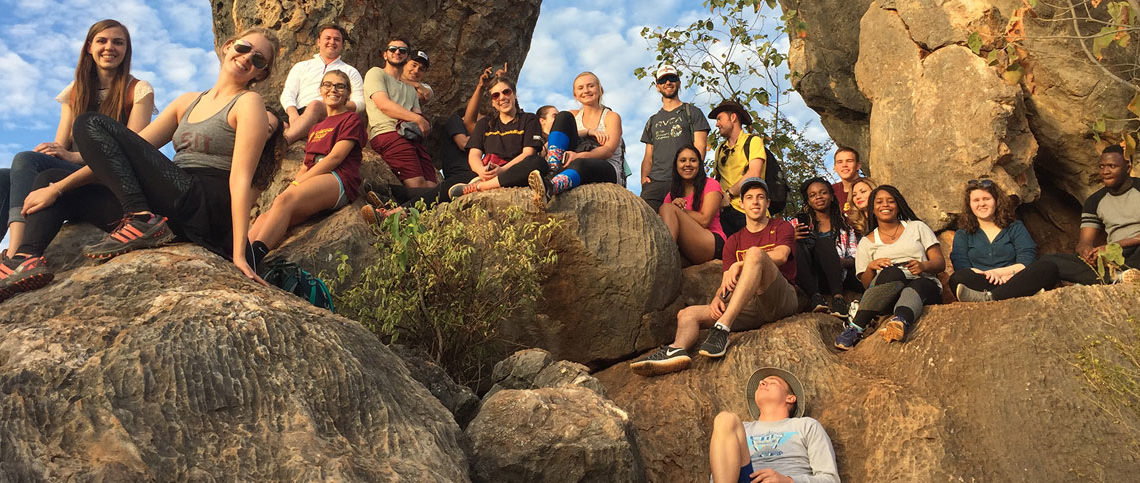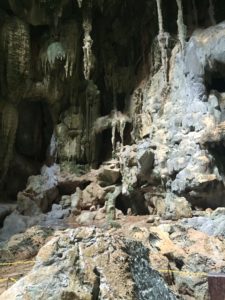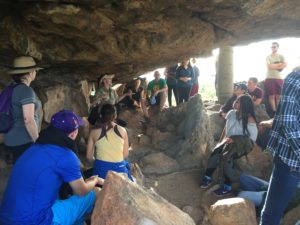
Jessica Fong, Arizona State University’s Barrett in Australia student blogger, writes: Chillagoe is exactly what I imagined the Outback to look like. What did I imagine it to look like you ask? Great question! Imagine a reddish-brown landscape, with sparse tree coverage and large rock formations surrounding the area. There are no large buildings and hardly any people around. That, my friends, is the Outback of my mind’s eye, and like I said, I wasn’t far off. In addition to the desert back home in Arizona, it is one of the most beautiful desert landscapes I have ever seen.
 The first day we arrived in Chillagoe, our amazing tour guide, Claire, took us on a 10-minute walk to a quaint spring-fed creek. By the time we reached the water, my feet were coated in a light layer of dust from the dirt roads we walked on. I didn’t go swimming because I’m a total baby when it comes to even slightly cold water, but the rest of my classmates had no problem taking a swim in nature’s swimming pool. Trees surrounded us and the chirping of birds could just be heard over the sound of the waterfall. It was a wonderful way to start our visit here.
The first day we arrived in Chillagoe, our amazing tour guide, Claire, took us on a 10-minute walk to a quaint spring-fed creek. By the time we reached the water, my feet were coated in a light layer of dust from the dirt roads we walked on. I didn’t go swimming because I’m a total baby when it comes to even slightly cold water, but the rest of my classmates had no problem taking a swim in nature’s swimming pool. Trees surrounded us and the chirping of birds could just be heard over the sound of the waterfall. It was a wonderful way to start our visit here.
The next few days wer e filled with constant activity. We visited the Royal Arch Caves and took a tour through the winding tunnels underneath a 45-kilometer stretch of limestone. The walk itself was only 1.3 kilometers, but we saw everything from lofty caverns to palm-sized cave spiders and bats living in the darkness. At one point during the tour, we had the option to crawl on our stomachs through a small opening along the ground. After two or three meters it opened up to a narrow cavern that led to a short limestone slide. We got a little dusty, but it was totally worth it!
e filled with constant activity. We visited the Royal Arch Caves and took a tour through the winding tunnels underneath a 45-kilometer stretch of limestone. The walk itself was only 1.3 kilometers, but we saw everything from lofty caverns to palm-sized cave spiders and bats living in the darkness. At one point during the tour, we had the option to crawl on our stomachs through a small opening along the ground. After two or three meters it opened up to a narrow cavern that led to a short limestone slide. We got a little dusty, but it was totally worth it!
After the cave tour in the morning and lunch at the Ecolodge in the afternoon, our class visited several indigenous rock art sites. These sites are home to drawings that are literally tens of thousands of years old. Part of Aboriginal culture is to teach their young to draw these images, which they do by having them trace the patterns on the rock. This frequent retracing is why we can still see the images today. Even though the drawings are so old and should be faded away, the pigment on the rock is only a few hundred years old versus thousands of years old.
To wrap up our day, we hiked up to Balancing Rock to watch the sunset. We settled ourselves just in front of the giant rock formation and chatted as the sun sunk lower and lower in the sky.
Living in the Outback is an entirely different experience than living in the city. The town consisted of less than 200 permanent residents and they are at least a two-hour drive from any major city. While you have to be mindful of local fauna, the primary concern in the desert is water consumption. You have to stay hydrated (i.e. drink 2 – 3 liters everyday), but you also need to conserve water. If you think California or Arizona don’t get much rainfall, just go visit Chillagoe!








